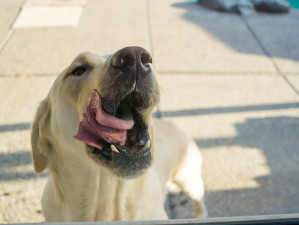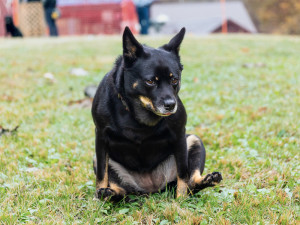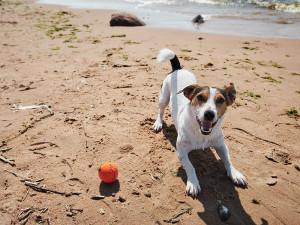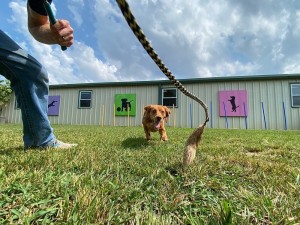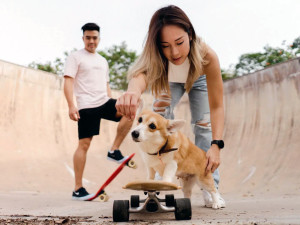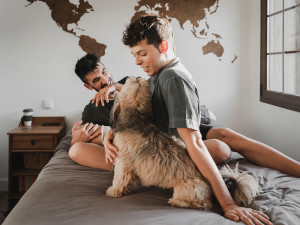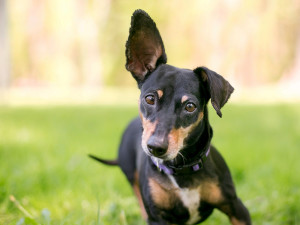Crotch Sniffing: Crude Or Customary?
Is it time to teach your dog some boundaries?
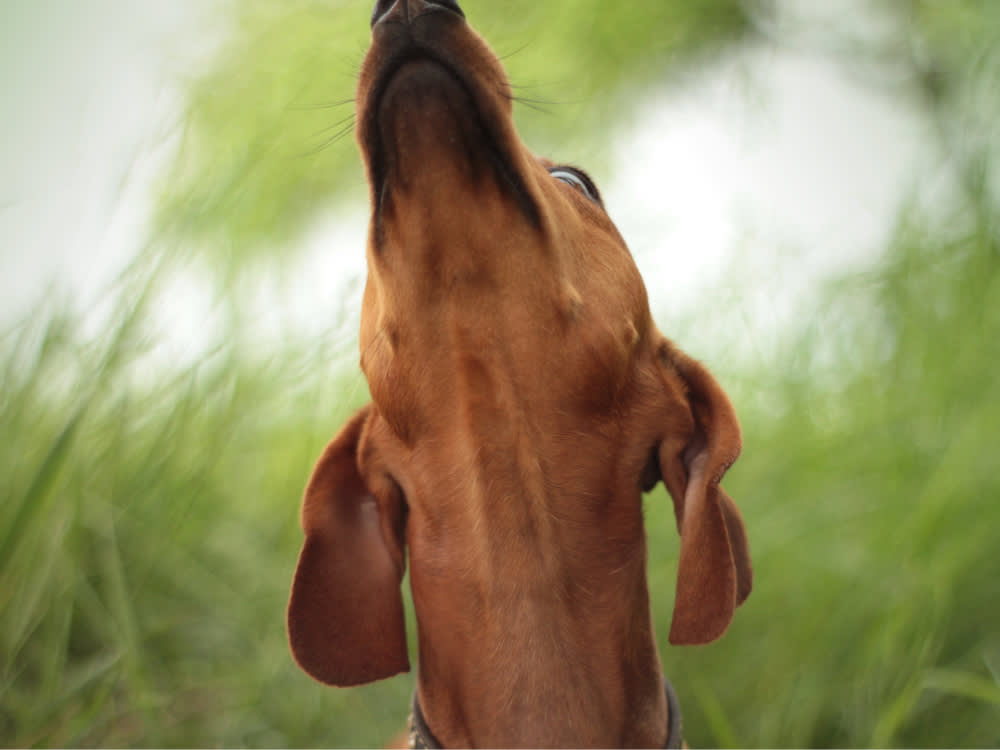
Share Article
Some dog behaviours are super0cute: that confused semi-turn of their head when you ask them a question or when they nuzzle into your body on the couch. Other behaviours, though, can be embarrassing and borderline rude – like when your dog tries to smell a stranger’s crotch while you’re out on a walk. Awkward.
Your instinct might be to suppress this kind of behaviour, but it’s important to understand that crotch sniffing is perfectly appropriate in dog speak. Dogs are still dogs, even though you consider them part of your family. Understanding why they perform certain behaviours (like crotch smelling) will make it easier to know what’s normal and what’s not. Keep reading to learn what to do about a crotch-sniffing dog.
Born to sniff
As a canine behaviourist and trainer, one of the questions I am asked frequently is, “How can I stop my dog from sniffing everyone’s crotch?” As with all behaviour modification, the key is to understand the root cause of the issue.
A dog’s most dominant sense is their sense of smell, and sniffing is one of their most natural behaviours. With a scent sensitivity many thousands of times greater than our own, dogs have a specialised structure within their nasal cavity called the olfactory recess. This maze of airways allows dogs to sniff odours that are undetectable to us. Dogs have 125 to 300 million olfactory cells (compared to our mere 5 million), and 33 percent of their brain is dedicated to interpreting odours.
Research by scientists at Pennsylvania State University showed that dogs have the incredible ability to take a different odour into each nostril and analyse it. They are a species of superior sniffers. Dogs make sense of the world through scents, much in the same way that people rely heavily on vision.
Why do dogs smell your crotch?
First, it helps to understand the reason that dogs sniff each other’s bums: dogs have pouches located on either side of the sphincter called anal glands or anal sacs. They are lined with oils and sweat glands, and they release an odour that is unique to each dog. When dogs take in the scent produced by these glands, they are able to gather a lot of information about the other dog including sex, age, health, mood and wellbeing.
If we transfer that to humans, our sweat glands and the scent they produce is often most concentrated around our genital areas and armpits. As most dogs cannot easily reach up to our armpits, the crotch is the go-to area to get the information they need on a new person.
To a dog, crotch sniffing is not bad manners. Dogs have no idea that placing their noses into the crouch of a human is not socially acceptable. We need to teach them that when it comes to people, we would prefer an alternative method to get to know each other.
How to put a stop to crotch sniffing
It can be relatively easy to squash this behaviour with consistency, and by heavily rewarding your dog when they choose not to smell someone’s crotch. While you can’t train out the innate behaviour, it can be redirected. The key to training away unwanted crotch sniffing is to offer an alternative region for your dog to gather the information they want and gently block the current go-to area. Each time your dog attempts to crotch sniff, follows these simple steps:
Give a clear instruction to stop and if necessary, include a previously learned command such as ‘wait’. For example: “No Rover, wait,” or “No, Rover, look at me.”
Offer a hand slowly and palm up for inspection, while turning the crotch away or blocking it with something. This area of the hand also carries a lot of sweat glands and can be sufficient to gather the information they need to satisfy them.
Reward heavily with praise when your dog reacts to the hand. Training treats will also encourage sniffing hands rather than crotches. Timing, as always, is key. Give them enough time to sniff and then immediately offer the treat.
If you have a more insistent dog, start with placing your dog on a lead. If they are trying to get to the crotch and will not accept the hand being offered, stand still, keeping them back. Do not yank them back. The only pressure being applied on the lead should come from your dog. Allow them to calm down a little. Maybe walk them around and retry, showing them a hand when returning to the visitor.
If they get to a crotch before you can prevent them, the owner of the crotch should gently push them away while turning. Once you have control of your dog, repeat by offering the hand and rewarding your dog’s decision to sniff that instead. The idea is to show your dog how you want them to behave. When your dog sniffs hands instead of crotches, always give them a signal that this is the right thing to do (say ‘good dog’ or ‘yes’). Most dogs understand within a few months that hand sniffing is more socially acceptable than crotch sniffing and that it will result in special praise from you or a tasty treat. After some time consistently training this, hand sniffing becomes conditioned over crotch-sniffing.
It’s best to start this training at home, using family and visitors to practise on. Setting a dog up for success in a controlled environment where you are unlikely to feel pressure or embarrassment goes a long way to change their behaviour long-term.

Emma Bowdrey, ISCP
Emma Bowdrey is an ISCP-trained Dog Trainer based in Prague, where she lives with her adopted greyhound, Swift. Emma has worked with dogs since gaining her qualification in Canine Behaviour & Psychology and now runs her own business - Four Long Legs. Emma uses positive reinforcement methods to make each hound a happy one.
Related articles
![Golden Retrieve dog running in the grass outside, playfully chasing a flirt pole held by a man in blue jeans]()
Your Dog Is Bored. Here’s How to Solve That
Get out the toys and puzzles
![Pet parent Victoria Cheng and her partner in a skate park trying to teach their Corgi dog to skateboard with treats]()
How to Teach Your Dog to Skateboard
They’ll be doing ollies in no time
![Same sex couple with their dog lying on the bed laughing at his farts]()
Here’s Why Your Dog Farts So Much
Expert solutions for your pup’s flatulence
![Puppy with one ear up an done ear down.]()
All Ears: 10 Fun Facts About Your Dog’s Ears
There’s a lot more to your pup’s furry appendages than you’d think

